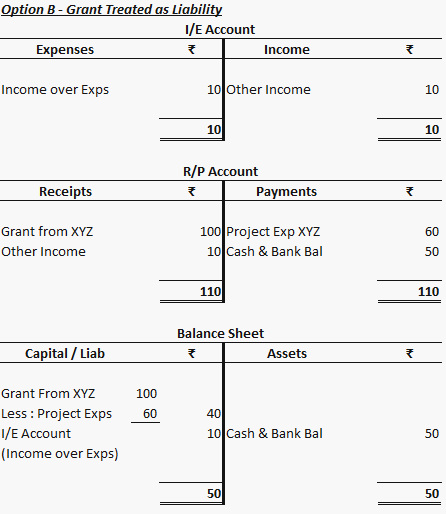Accounting of Grants for NGOs
Do you know how Grant is presented in your NGOs Financial Statements? As REVENUE or as LIABILITY ? This is one of the crucial question regarding accounting of Grants for NGOs. Generally, we depend on the Chartered Accountants on how our Financial Statements are prepared and presented. Sometimes presentation of Financial Statements become misleading and serve no purpose.
Today we learn how to do accounting of grants for NGOs which is more appropriate in present days.
Introduction – Accounting of Grants for NGOs
There is no clarity Inida regarding how grants should be presented. We have Indian Accounting Standard 20 which mainly dealt with accounting of Government Grants and not grants for specific projects from Funding Agencies. However, considering Indian Accounting Standards #20 and US Statement of Financial Accounting Standard #117, we can derive following three methods of presenting Grants in the Financial Statements.
Option A – Grants treated as Revenue
Here, we consider Grants Received as Revenue of the current year whether it is related to current year or for next years. Thus, when two years project is sanctioned and total grant received in the first year only, we treat full grant as income of first year. See below image to understand presentation in Financial Statements.
In this method, you can see above that unspent grant of Rs 40 clubbed in Income and Expenditure Account as “Excess of Income over Expenses” . Due to this, it becomes difficult to know what funds lying in the I/E Account. Check out the Balance Sheet where I/E Account show Rs. 50 which comprise of Unspent Grants and Other Income.
Option B – Grant treated as Liability
Here, it assumes that, grants and funds received for specific project, is the liability of organization and not Income. Thus whatever grant received, whether for current year or next years taken to Balance Sheet and considered as Liability. Expense from such grant then deducted from the liability and net amount shown in the Balance Sheet. Checkout below how Financial Statements look if we treat Grant as Liability.
In this method, Balance Sheet present correct financial position. However, Income and Expenditure does not show much revenue except income earned by NGOs like Non Specific Donations and Interest Income.
Option C – Best of the above Two
Due to limitations of both the above method, we should presented financial statements as per this hybrid method using best of both the above methods. In this method, we consider that much revenue for current year which actually spent during the year and remaining balance transfer to next year as “Unspent or Unutilized Grant”. Lets have a look, how the financial Statements presented under this method.
In this method, Income Expenditure Account and Balance Sheet showing correct information and in self explanatory manner.
Conclusion
In India, there is no such proforma available in any Act regarding presentation of Financial Statements of NGOs. Thus as per my opinion it is advisable to follow accounting of grants for ngos as per option C – Hybrid method, which is self explanatory and showing correct information.
Note – In all the above three methods, presentation of Receipts and Payment Accounts would not change.
For any questions or query hit the below comment section.













There are grants which allow utilisation of the same for purchase of assets for the project in addition to meeting the project expenditure.
in such cases can the amount spent for purchase of assets be shown as “expenditure” and the assets kept in the books at a nominal value of Rs1/= for control purposes?
It is better to show assets at actual value instead of Rs. 1 and on the liability side create “Fixed Assets Fund from Funding Agency” of same amount.
It should work like this –
1) Entries when you purchase fixed assets
Budget Head Expenses(dr)
To Cash/Bank(cr)
2) When you capitalize FA
Fixed Assets(dr)
To Reserve for Fixed Assets(cr)
As per my opinion, one should not charge depreciation on the fixed assets purchased from donors fund. Because it is already debited to I/E in full. Still if you want to calculate dep, pass this entry instead of reducing fixed assets amount by dep.
3) Dep entry
Dep A/c(dr)
To Income and Exp (cr)
Kindly explain I m looking for clear understanding of purchasing of fixed assets out of donor fund.
Waiting for your reply. Thanks in advance
How to maintain the separate set of account for domestic fund and foreign fund in single tally company ?
If you maintain FC and NonFC in a Single Tally Company, then it is not a separate set of accounts. Thus it is advisable to have two companies in Tally – FC and NonFC
Please let us know whether the said system (option C – Hybrid method) is accepted by Income Tax Department and we dont need to file Form 10 or 9A.
Most of the organization choosing Option C only. You are not concealing any income. Also, you are transferring the advance grant to next year and thus logically method C is correct.